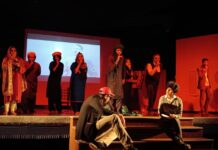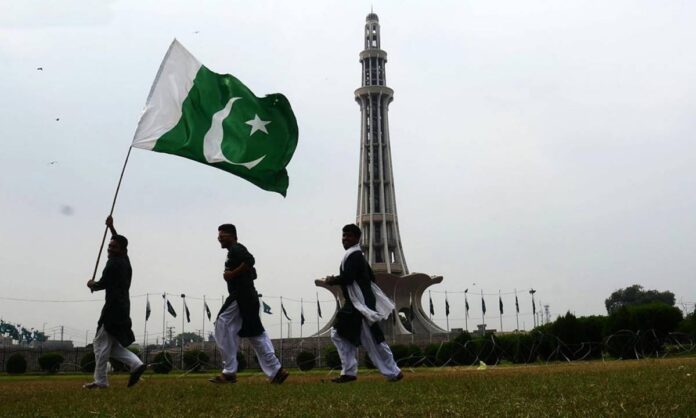Pakistan’s long dark night has lasted 76 years now. And still there seems to be no end in sight. One hopes that collective wisdom will prevail but this is just a hope for now.
In the Game of Thrones, a series of fantasy novels by George RR. Martin, the Long Night is how the Westerosi refer to a period when a terrible darkness befell the known world. Eventually, the First Men and the Children of the Forest formed an alliance and defeated the White Walkers and brought an end to the Long Night. The Battle was led by Azor Ahai who had a great sword of fire called Lightbringer. He also died a valiant death during this battle.
Pakistan is no fantasy land and its chequered history is no fantasy novel. No Azor Ahai with his sword Lightbringer will come forward to lead Pakistan out of its long dark night. Ultimately, it is up to the common people of Pakistan if ever they wake up from their deep slumber to end this long night.
Pakistan’s predicament continues to be no rule of law as well as utter disregard of the constitution. The country continues to face insurmountable challenges and is stuck in the midst of political, constitutional, economic and security crises. The governance model, if ever there was any, has completely failed. A military junta in front, middle or at the back also has not worked. At some stage, the continuous experimentation with governance models (civilian, military, hybrid) need to end and we need to give people their voice in what matters most to them.
There is only one way to effectively deal with these seemingly insurmountable challenges and that is through collective wisdom and people’s support. Collective wisdom is often defined as shared knowledge arrived at by individuals and groups, used to solve problems and conflicts. It is also the ability of the groups to use their knowledge and experience to make good decisions. This, however requires an assessment of the current operating environment faced by Pakistan which can be described thus:
- A population of over 240 million with a demography in which the median age is around 20. Almost 65 percent are under 30 and around 30 percent between 15 and 29,
- An economy in tatters with rising inflation and unemployment. This is further aggravated with increasing income disparities as increasing numbers fall below the poverty line
- Most of the state institutions have failed to deliver; whether it is bureaucracy, police, judiciary or others
- Crumbling social services infrastructure, including health and education
- Lack of tolerance and rise of extremism of all sorts combined with resurgence of terrorism
- Increasing use of social media and technology
- Impact of climate change
- Increasingly complex geopolitics of USA-China/Russia confrontation and a neighbourhood including India, Afghanistan and Iran
What can be resolved through dialogue and negotiation will be longer than what is forced. Use of force will only further weaken the federation. Pakistan’s problems can only be solved within Pakistan by Pakistanis themselves. Given the magnitude of the rot occurring over many decades, these challenges will take at least a decade to reverse and only then perhaps the country can move in the right direction.
Since April 2022 while things took a disastrous turn for the worse in some ways, it has also stripped bare all the weaknesses in the current status quo. Never in Pakistan’s history has the rottenness of the entire system been exposed as in these past months. It appears there is no vision or long-term thinking. Society’s moral and social fabric seems completely broken down. Over the past several decades was the country mostly governed by psychopaths in turn were served and supported by sycophants?
Getting down to realpolitik, we observe a number of changes within the power dynamics in the system and its main stakeholders. This is assuming ordinary citizens have never been stakeholders in this system which is led and managed by the elites. Common citizens have not had much influence over these power dynamics except to cast their votes. Following themes emerge for the key players in the recent power struggles.
- While the military still continues to be the strongest institution in the country and wields most of the actual power as well as fire power, this may not be so in coming years. Its credibility has weakened significantly since the ouster of the PTI government.
- The military’s own space for manoeuvring is currently quite limited given that there is no Russian invasion of Afghanistan nor an international war on terror led by the USA, and hence not much dividends to reap from the West. And there is no fiscal space given IMF conditionalities.
- Unlike the past, people have better and wider access to technology and social media together with a large young population. Over the past few decades, the military has moved into spheres that are neither its domain specialization nor in accordance with its primary mandate.
- As history tells us this generally does not bode well for the institution itself or the nation-state especially in the case of Pakistan with its social, ethnic and religious fault lines. This in itself should be a reason enough to avoid use of force and negotiate a governance model that is transparent and accountable as well as supported by the general populace. All successful corporations in the context of a corporate world have governance models where authority and accountability rests in the same place. Given Pakistan’s own history of flip-flopping between military, civilian and hybrid regimes, it seems legitimacy will continue to elude the military. Even a formal hybrid governance model would only work if supported by a majority, and accountability must be across the board and not just for civilian governments or institutions.
- The PTI and Imran Khan have been pushed back in every possible way. While the PTI may have lost its ability to organize and function effectively, it seems likely to win a majority if and when free and fair elections are held. It would make good sense for PTI and its chairman to step back a little from their stated position and accept or work on a new social contract with other key stakeholders while staying true to its commitment to primacy of the rule of law.
- It is the sharp divides between parties and political players that created a vacuum for the Army to play a more active role. Whether it is a charter of democracy combined with a charter of economy, the PTI may have to tone down its rhetoric on corruption related to PDM parties as well as regime change. Maybe the focus on eradicating corruption can begin from 2024 onwards and not retroactively, though this should mean that rule of law is applied to everyone including the powerful and not just the common people going forward.
- For PDM parties including the PPP and PML(N), they have more or less lost all political capital and credibility among the public. They need to stop blaming the PTI and Khan for everything wrong with Pakistan– they know better, and are aware what the real issue is. Khan and his party cannot be blamed for Pakistan’s woes that have been in making for decades.
- Part of the blame also rests with Khan. Khan’s lack of understanding of Machiavellian politics and possible naivety about the military’s own interests, so a political vacuum was created which was filled by the then COAS. Maybe PDM can work on a formula where no one over 50 is a candidate for PM from their platform or let someone outside of the Sharifs and Zardaris become leaders of these parties while they remain in the background. And they can build upon from there. The focus needs to be on a new social contract and a charter of democracy and economy and not on vendetta and victimisation. This can start with a good will gesture by releasing all political prisoners and withdrawing frivolous cases against PTI and its leaders.
It would not be wrong to say that all institutions including parliament, judiciary, bureaucracy, police and others seem to have lost credibility. While at the same time, no one person, political party or institution can get Pakistan out of the present mess. This can only happen through collective wisdom and action by all key stakeholders with the support of the people. The foundation of long term sustainable economic growth can only be based upon rule of law that includes strong efficient institutions operating within the ambit of their respective mandate. No government of technocrats or billions in foreign direct investments alone can achieve this. Till this is understood by all stakeholders and powerbrokers there is no moving forward. No one can be above the law.
What can be resolved through dialogue and negotiation will be longer lasting than what is forced. Use of force will only further weaken the federation. Pakistan’s problems can only be solved within Pakistan by Pakistanis themselves. Given the magnitude of the rot occurring over many decades, these challenges will take at least a decade to reverse and only then perhaps the country can move in the right direction.
The real question is if collective wisdom will prevail together with a will and commitment to break away from the status quo or will Pakistan just tumble through life and tumble out of it at some point, like, as the historian Stanley Lane-Poole famously wrote, emperor Humayun tumbled through life, and he tumbled out of it.























